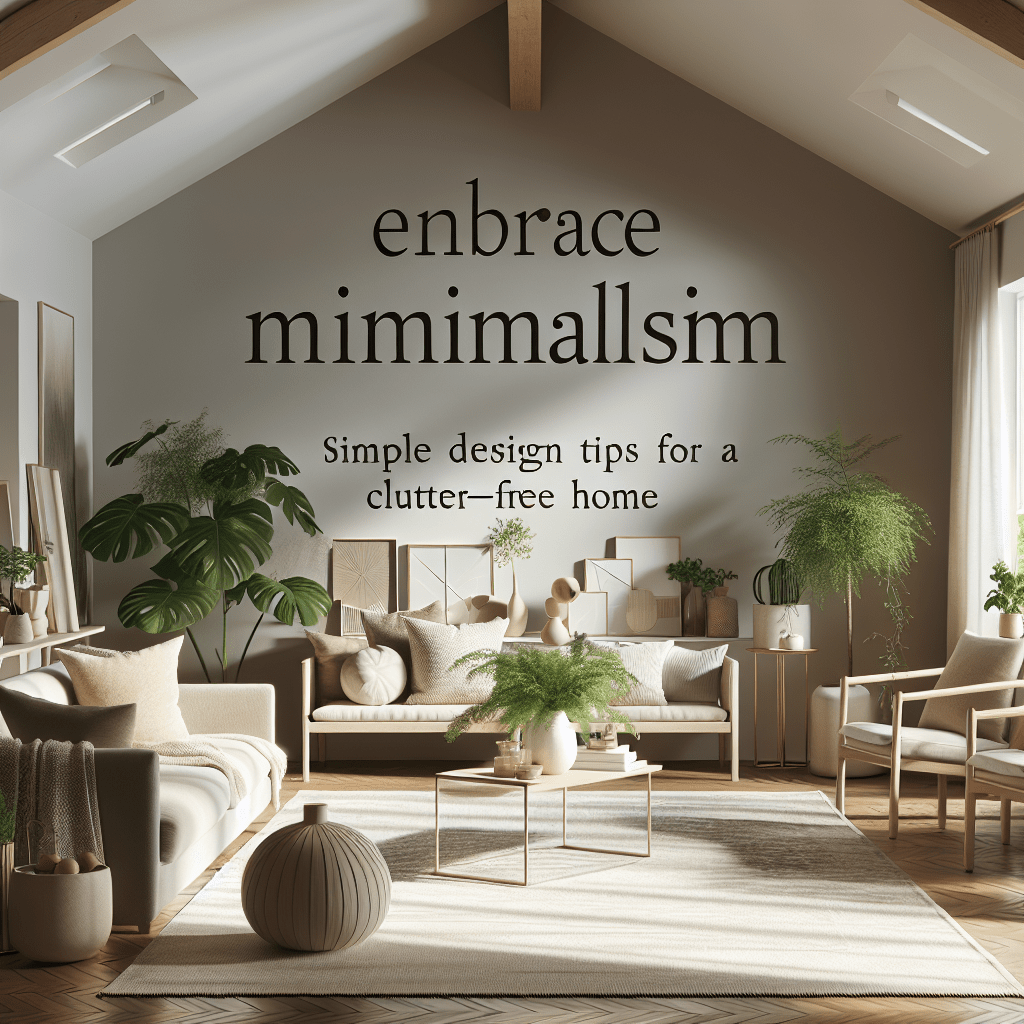In today’s fast-paced world, the concept of minimalism has gained popularity as people seek refuge from the chaos that surrounds them. Embracing minimalism in your home can lead to enhanced mental clarity, reduced stress, and a more serene living environment. This article will explore simple design tips to help you create a clutter-free home that reflects a minimalist ethos.
Understanding Minimalism
At its core, minimalism is about stripping away the excess to focus on what truly matters. It’s not just about having fewer possessions; it’s also about creating a peaceful and functional space. A minimalist home encourages intentional living, allowing you to appreciate the things you truly love.
Start with Clutter Reduction
The journey toward minimalism begins with decluttering. Here are some effective strategies:
- Assess Your Belongings: Go through your items room by room. Decide what to keep based on utility and emotional value.
- One In, One Out Rule: For every new item you bring into your home, consider removing one. This helps maintain your space’s integrity.
- Purge Regularly: Schedule regular decluttering sessions—monthly or seasonally—to keep your home free from unnecessary items.
- Organize Storage Areas: Utilize boxes, baskets, and organizers to keep items neatly stored away without visual clutter.
Choose a Minimal Color Palette
Colors have a profound impact on the vibe of a space. For a minimalist home, select a cohesive color scheme to promote tranquility:
- Neutral Colors: Whites, grays, and beiges provide a calm backdrop that makes spaces feel larger and more inviting.
- Accent Colors: Introduce one or two soft accent colors for warmth and personality, but avoid overwhelming hues that clash.
- Natural Materials: Consider incorporating wood, stone, or plants to add texture while maintaining the clean look of simplicity.
Opt for Simple Furniture and Decor
Your choice of furniture and decor can significantly affect the minimalism of your home. Follow these tips:
- Functional Furniture: Select furniture pieces that serve multiple purposes, such as ottomans with storage or coffee tables that double as workspaces.
- Avoid Over-Decoration: Choose fewer decor items that resonate with you, and showcase them in a meaningful way without creating visual clutter.
- Quality Over Quantity: Invest in fewer but high-quality pieces that will stand the test of time and bring you joy.
Embrace Open Spaces
Open, airy spaces promote a sense of peace and tranquility. Here are some ways to achieve this:
- Minimize Furniture Size: Opt for smaller pieces that allow for ample walking space and visual openness.
- Use Mirrors: Mirrors can create a sense of depth and expand the space, giving the illusion of larger areas.
- Declutter Surfaces: Keep countertops and tables clear; a clean surface can dramatically improve the feel of a space.
Incorporate Nature
Bringing the outdoors in can enhance the minimalist aesthetic while improving your well-being. Consider these suggestions:
- Add Plants: Incorporating houseplants not only purifies the air but also adds a touch of life without overwhelming the senses.
- Use Natural Light: Maximize natural light by using sheer curtains or keeping windows unobstructed. Sunlight can enhance mood and create a warm ambiance.
- Opt for Natural Decor: Include natural elements such as wood or stone in your decor to evoke a calming atmosphere.
Be Intentional with Lighting
Lighting plays a crucial role in creating the right ambiance in a minimalist home. Follow these tips:
- Layer Your Lighting: Use multiple sources of light (overhead, task, and ambient) for adjustable brightness and mood.
- Choose Simple Fixtures: Opt for clean, understated lighting fixtures that complement your minimalist design.
- Embrace Natural Light: Position mirrors near windows to reflect light and make rooms feel brighter and more expansive.
Maintain a Clutter-Free Mindset
Minimalism isn’t just about physical decluttering; it’s a mindset. Cultivating a clutter-free mindset helps maintain the clarity of your home:
- Mindful Purchasing: Consider the necessity and value of each item before purchasing it. Ask yourself if it genuinely adds value to your life.
- Practice Mindfulness: Engage in mindfulness practices such as meditation or journaling to promote mental clarity and peace.
- Evaluate Emotional Attachments: Let go of items that no longer serve your current lifestyle or emotional well-being.
Organizing for Minimalism
Efficient organization methods can facilitate a minimalist lifestyle. Here are some proven approaches:
- Zoned Spaces: Designate specific areas in your home for related activities, ensuring everything has a designated place.
- Color-Coding: Use color-coding for storage units and bookshelves to simplify the organization process and enhance visual appeal.
- Accessible Storage: Make sure frequently used items are easily accessible to avoid frustration and clutter.
Conclusion
Embracing minimalism in your home doesn’t need to be an overwhelming process. By implementing simple design tips and maintaining an intentional mindset, you can transform your space into a clutter-free haven that nurtures peace and clarity. Remember that minimalism is a personal journey; tailor your approach to suit your lifestyle and preferences.
FAQs
What is minimalism?
Minimalism is a lifestyle that encourages simplifying one’s life by reducing material possessions and focusing on what truly brings joy and fulfillment.
How can I start decluttering my home?
Begin by evaluating each item you own, deciding what to keep based on its utility or emotional significance. Tackle one room at a time for a more manageable approach.
Is minimalism suitable for everyone?
While minimalism can be beneficial for many, it isn’t a one-size-fits-all solution. It’s essential to adapt the principles of minimalism to your personal needs and lifestyle.
How often should I declutter my home?
It’s advisable to declutter regularly—at least once a month or seasonally—to prevent unnecessary accumulation of items and maintain an organized space.
Can minimalism help with stress?
Yes, minimalism can help reduce stress by creating a more organized space and promoting mental clarity, allowing you to focus on what truly matters.
#Embrace #Minimalism #Simple #Design #Tips #ClutterFree #Home
